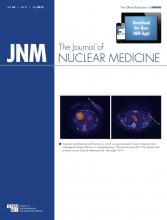Amino acids for oncologic imaging: Huang and McConathy provide an overview of this class of molecular imaging agents, including radiolabeling considerations and key clinical applications.
Amyloid PET AUC update: Johnson and members of the SNMMI and Alzheimer’s Association Amyloid Imaging Task Force provide clarification and additional detail on previously published appropriate use criteria for amyloid PET imaging in Alzheimer disease.
VEGF-A imaging in primary breast cancer: Gaykema and colleagues determine whether vascular endothelial growth factor-A in primary breast cancer can be visualized with 89Zr-bevacizumab PET.
VPAC1 receptors and breast cancer imaging: Thakur and colleagues describe a feasibility study with a novel 64Cu-labeled PET agent with the potential for distinguishing malignant from benign breast lesions.
EORTC and PERCIST response evaluation: Skougaard and colleagues compare these 2 widely used criteria in response evaluation of patients with metastatic colorectal cancer treated with a combination of the chemotherapeutic drug irinotecan and the monoclonal antibody cetuximab.
PET prognosis in salivary gland carcinomas: Ryu and colleagues look at the predictive value of metabolic tumor and total lesion glycolysis assessed by pretreatment 18F-FDG PET/CT in patients with intermediate- or high-grade salivary gland carcinomas.
PET/CT and nasal-type NK/T-cell lymphoma: Moon and colleagues explore the potential of 18F-FDG PET/CT in cancer staging by comparing results with those from conventional staging methods in patients with this aggressive lymphoid neoplasm.
177Lu-DOTA-rituximab therapy: Forrer and colleagues determine the maximum tolerated dose of and clinical response to 177Lu-DOTA-rituximab in treatment of patients with relapsed follicular, mantle cell, and other indolent lymphomas.
PET and DWI in osteosarcoma: Byun and colleagues evaluate the ability of serial 18F-FDG PET/CT and diffusion-weighted MR imaging to monitor histologic response in patients with extremity osteosarcoma receiving neoadjuvant chemotherapy.
PET and HIF-1α in OSCC: Sato and colleagues elucidate correlations between 18F-FMISO PET findings and hypoxia-inducible factor-1α expression in patients with oral squamous cell carcinoma.
Frontotemporal degeneration and Granulin mutations: Premi and colleagues detail 99mTc-ECD SPECT imaging results in healthy controls and frontotemporal lobar degeneration patients with and without Granulin gene mutations to look at specific patterns of brain connectivity.
Striatal DAT in DLB: Ziebell and colleagues use 123I-PE2I SPECT to correlate striatal dopamine transporter availability with core characteristic features and symptoms of dementia with Lewy bodies in newly diagnosed patients.
V/Q SPECT PE interpretation criteria: Roux and colleagues compare the performance of ventilation–perfusion SPECT using various interpretation criteria with that of a validated independent diagnostic strategy in confirming or excluding acute pulmonary embolism.
Interim PET in Hodgkin lymphoma: Kostakoglu and Gallamini offer an educational review of the integral role of interim 18F-FDG PET imaging in Hodgkin lymphoma, as well as challenges to integration and routine use, critical issues to improve accuracy, and current supporting study and trial data.
PET imaging of EphB4: Liu and colleagues outline development and initial studies with a series of 64Cu-labeled antibodies for PET imaging of tumor ephrin type B receptor 4 expression, with implications for evaluating early-stage treatment using anti-EphB4 strategies in colorectal, breast, and other cancers.
18F peptides for integrin αvβ6 imaging: Hackel and colleagues evaluate 2 cystine knot peptides for 18F labeling and PET imaging of BxPC3 pancreatic adenocarcinoma xenografts in mice, with promise for molecular imaging of integrin αvβ6 overexpression in pancreatic and other cancers.
PET and tumor hypoxia: Valtorta and colleagues describe the kinetics of 64Cu-ATSM distribution in different cancer models, using 18F-FAZA as a gold standard, with a focus on the implications of cell-dependent distribution and retention.
Hyperpolarized [1-13C]MRSI and 18F-FDG PET: Menzel and colleague compare 13C MR spectroscopic imaging with 18F-FDG PET imaging in tumor metabolism visualization in rats with subcutaneous hepatocellular carcinoma.
Novel PET brain tumor agent: Solingapuram Sai and colleagues compare the effectiveness of 18F-AFETP, a structural analog of histidine, with that of 18F-FET in PET imaging of brain tumors in a murine model of glioblastoma.
18F-florbetaben PET in mice: Rominger and colleagues report on the longitudinal progression of β-amyloid deposition in brains of mice overexpressing Swedish mutant β-amyloid precursor protein, a model of Alzheimer disease, as assessed by 18F-florbetaben PET.
PET and chemokine receptors: Liu and colleagues detail the development of a positron emitter–radiolabeled probe to image the upregulation of chemokine receptor in a wire-injury–accelerated apolipoprotein E knockout mouse model of atherosclerosis.
PET and norepinephrine: Higuchi and colleagues investigate the mechanisms of cardiac uptake of a novel PET imaging agent, 18F-LMI1195, in healthy rats, with and without pretreatment with norepinephrine uptake-1 and -2 inhibitors.
T-cell PET for rejection diagnosis: Grabner and colleagues investigate small-animal PET with 18F-FDG–labeled T lymphocytes as a new method for image-based diagnosis of acute allogeneic renal transplant rejection established in a rat model.
Curie-level NCA 18F-FDOPA production: Libert and colleagues propose and outline a simplified, no-carrier-added approach to production of 18F-FDOPA, resulting in automation of the synthesis in a commercially available module.
High-performance bench-top scanner: Herrmann and colleagues look at the performance of the Genisys4, a small bench-top preclinical PET device, and compare the results with those from a well-established preclinical PET scanner.
- © 2013 by the Society of Nuclear Medicine and Molecular Imaging, Inc.







